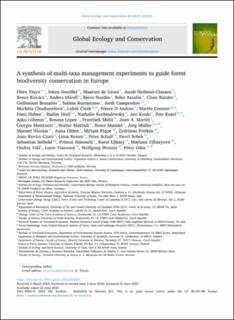A synthesis of multi-taxa management experiments to guide forest biodiversity conservation in Europe
Tinya, Flóra; Doerfler, Inken; de Groot, Maarten; Heilman-Clausen, Jacob; Kovács, Bence; Mårell, Anders; Nordén, Björn; Aszalós, Réka; Bässler, Claus; Brazaitis, Gediminas; Burrascano, Sabina; Camprodon, Jordi; Chudomelov, Marketa; Cizek, Lukas; D'Andrea, Ettore; Gossner, Martin; Halme, Panu; Hédl, Radim; Korboulewsky, Nathalie; Kouki, Jari; Kozel, Petr; Lõhmus, Asko; Lopez, Rosana; Máliš, František; Martín, Juan A.; Mattioli, Walter; Mundet, Roser; Müller, Jörg; Nicolas, Manuel; Oldén, Anna; Piqué, Miriam; Preiksa, Zydrunas; Ciuró, Joan Rovira; Remm, Liina; Schall, Peter; Sebek, Pavel; Seibold, Sebastian; Simoncic, Primoz; Ujhazy, Karol; Ujhazyova, Mariana; Vild, Ondrej; Vincenot, Lucie; Weisser, Wolfgang; Odor, Peter
Peer reviewed, Journal article
Published version

Åpne
Permanent lenke
https://hdl.handle.net/11250/3075577Utgivelsesdato
2023Metadata
Vis full innførselSamlinger
- Publikasjoner fra CRIStin - NINA [2364]
- Scientific publications [1392]
Originalversjon
10.1016/j.gecco.2023.e02553Sammendrag
Most European forests are used for timber production. Given the limited extent of unmanaged
(and especially primary) forests, it is essential to include commercial forests in the conservation of
forest biodiversity. In order to develop ecologically sustainable forest management practices, it is
important to understand the management impacts on forest-dwelling organisms. Experiments
allow testing the effects of alternative management strategies, and monitoring of multiple taxa
informs us on the response range across forest-dwelling organisms. To provide a representative
picture of the currently available information, metadata on 28 multi-taxa forest management
experiments were collected from 14 European countries. We demonstrate the potential of
compiling these experiments in a single network to upscale results from the local to continental
level and indicate directions for future research. Among the different forest types, temperate
deciduous beech and oak-dominated forests are the best represented in the multi-taxa manage ment experiments. Of all the experimental treatments, innovative ways of traditional manage ment techniques (e.g., gap cutting and thinning) and conservation-oriented interventions (e.g.,
microhabitat enrichment) provide the best opportunity for large-scale analyses. Regarding the
organism groups, woody regeneration, herbs, fungi, beetles, bryophytes, birds and lichens offer
the largest potential for addressing management–biodiversity relationships at the European level.
We identified knowledge gaps regarding boreal, hemiboreal and broadleaved evergreen forests,
the treatments of large herbivore exclusion, prescribed burning and forest floor or water ma nipulations, and the monitoring of soil-dwelling organisms and some vertebrate classes, e.g.,
amphibians, reptiles and mammals. To improve multi-site comparisons, design of future experi ments should be fitted to the set-up of the ongoing projects and standardised biodiversity sam pling is suggested. However, the network described here opens the way to learn lessons on the
impact on forest biodiversity of different management techniques at the continental level, and
thus, supports biodiversity conservation in managed forests.
